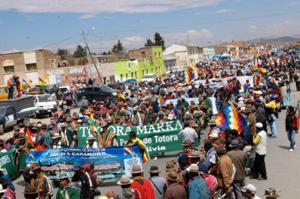|
Sources of Data:
Most of these statistics are taken from the 2011 United Nations Development Programme (UNDP) Human Development Report (HDR) and the World Bank’s 2011 World Development Indicators (WDI) .
Human Development Index (HDI)
Bolivia was ranked 108th of 169 countries in the Human Development Report 2011, with an HDI value of 0.663 (The UK was ranked 28th with an HDI value of 0.863). Bolivia’s HDI value is now the second lowest in South America, having moved just below Paraguay. Regionally Bolivia now ranks above Haiti, Nicaragua, Honduras, Guatemala and Guyana.
A higher numerical value represents improvements in any or all of the HDI's three components: life expectancy, literacy and GDP per capita.
GDP per capita (PPP basis)*
US$4,054 (2011 Human Development Report)
US$4,502 (2010 Human Development Report)
US$4,206 (2009 Human Development Report)
* See UNDP web pages for definition and for other statistical information
GNI (Gross National Income) per capita*
US$1,790 (2010)
US$1,630 (2009)
US$1,460 (2008)
* Source: World Bank
Percentage of the population living on less than US$1.25 (PPP) a day
14,0 (2011)
Percentage of the population living on less than US$2 a day
25.1% (2007)
30.4% (2005)
Source: World Bank
Inequality - measured using Gini index and income distribution ratios*
Gini index:
57.3 (2007)
58.2 (2005)
60.1 (2002)
As a result of Bolivia’s slight reduction in inequality in recent years, it is no longer the most unequal country in Latin America. According to the most up to date figures, both Colombia and Haiti have higher levels of inequality. Bolivia’s income inequality is still relatively very high, and it remains one of the most unequal countries in the world. According to the United Nations Development Program, of those countries with available statistics, only Colombia, Namibia, Botswana, Haiti, Angola and Comoros are more unequal than Bolivia.
The level of inequality in Bolivia can be seen in the gulf between the share of income of the highest and lowest earning deciles of the population. In 2007, where the highest paid 10% of Bolivians earned 45.3% of the population’s total income, the lowest paid 10% earned merely 0.5%. This represents a ratio of 64.7:1.
*it should be noted when interpreting these figures that statistics on inequality, based on household surveys, are notoriously inaccurate.
Sources: World Bank
United Nations Development Program
Life expectancy at birth (estimate)
66.6 years (2011 - Human Development Report)
66.3 years (2010)
Literacy rate
2011 - 90.7%
2007/2008 Human Development Report:
Adult (15+) literacy 86.7% in 2004
Access to healthcare
Patchy across the population, with particularly restricted access in rural and highland areas.
Under-five mortality rate (per 1,000 live births)
51 (2011)
54 (2008)
NB: UK = 6 (2008)*
Total health expenditure per capita (PPP)
US$194 (2008)
US$200 (2007)
Doctors per 100,000 people
120 (2000-2009)
Percentage of births attended by trained health professionals
71% (2008)
Source: World Bank
HIV prevalence (% of population aged 15-49)
0.2% (2007)
Source: World Bank
NB: All statistics taken from UN Development Report 2011 unless otherwise specified.
|



